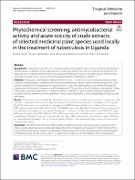| dc.identifier.citation | Oloya, B., Namukobe, J, Ssengooba, W, Afayoa, M, Byamukama, R (2022). Phytochemical screening, antimycobacterial activity and acute toxicity of crude extracts of selected medicinal plant species used locally in the treatment of tuberculosis in Uganda. Trop Med Health, 50(16) https://doi.org/10.1186/s41182-022-00406-7 | en_US |
| dc.description.abstract | Background
Tuberculosis (TB) is one of the leading causes of death globally, and the rise in drug-resistant forms of TB has become a significant threat. Subsequently, it is crucial to explore new, effective and safe anti-TB agents. This study aimed at conducting phytochemical screening, antimycobacterial activity, and acute toxicity of the selected plant species’ crude extracts to assess their toxicological potentials and efficacies against TB.
Methods
The aqueous and methanol/dichloromethane (DCM) (1:1) extracts of each selected plant species were subjected to phytochemical screening and antimycobacterial activity using microplate alamar blue assay. For acute toxicity, a single dose (2000 mg/kg) of the aqueous extracts was orally administered to each animal following the Organization for Economic Cooperation and Development (OECD) guidelines No. 425 and then observed for 14 days. The animals were closely observed on the general behavior and clinical signs of toxicity, and body weights were recorded. After the termination of the experiment, hematological, biochemical, and histopathological analyses were performed.
Results
The extracts contained alkaloids, flavonoids, tannins, saponins, steroids, terpenoids, resins, cardiac glycosides, phenolic compounds, and coumarins. Aqueous extracts showed moderate to weak activity against the susceptible (H37Rv) M. tuberculosis strain and weak activity against the MDR-TB strain with Minimum Inhibitory Concentrations (MIC μg/mL) ranging from 293.0–2344.0 and 1172.0–4688.0, respectively. Methanol/DCM extracts showed significant to moderate activity against the susceptible TB strain and moderate to weak activity against the MDR-TB strain with MIC (μg/mL) ranging from 98.0–586.0 and 293.0–781.0, respectively. One mortality was recorded from the A. coriaria treated group following the acute toxicity tests, but the LD50 of all the extracts was estimated to be above 2000 mg/kg. Histopathological analyses did not show any significant lesions in the examined organs except those from the A. coriaria treated group.
Conclusion
Phytochemical screening of the extracts revealed the presence of alkaloids, tannins, saponins, flavonoids, steroids, terpenoids, resins, cardiac glycosides, phenolic compounds, and coumarins. All the methanol/DCM extracts of the plant species studied have promising antimycobacterial activity. The selected plant extracts studied exhibited low acute toxicity levels except for A. coriaria and could be safe for formulations into herbal products. | en_US |

